- Read about eight saree types, one
better than the other, of Andhra Pradesh and Telangana. Each type has unique
designs.
Andhra Pradesh is
situated on the south eastern coast of India. Telangana was carved out of
Andhra a few years ago. Andhra has one of the longest coast lines running along
the Bay of Bengal, huge deposits of minerals and is very rich in agriculture
and textiles.
Andhra
Pradesh is well-known for its huge variety of traditional silk and cotton
saris. Many districts in Andhra Pradesh have their own unique weaving patterns,
styles and methods. Saris that are specific to a particular district are named
after their place of origin. Apart from the designs, the fabric that is been
used in making the sari is different from one district to another, it has its
own specialty and uniqueness.
Here
are the textiles of Andhra Pradesh.
1. Mangalgiri Sarees
Mangalgiri
fabrics have an ancient history.
The name is derived from the temple town of Mangalagiri which lies in the
Guntur district of Andhra Pradesh. The weavers’ community settled there is at
least 600 years old. The exquisite sarees are in demand across the world. About
40% of the Mangalagiri population is dependent on handloom weaving and allied industry
i.e. yarn dealers, traders, warpers, dyers etc.
Speciality
of the sarees lies in the basic textures made of fine cotton yarn. Extra warp
design in the border enhances the beauty of the sarees.
Weaving Process
The
pure cotton yarns are first dipped in boiling water to remove impurities, then
soaked and rinsed overnight. The yarns are then sent for dyeing and finally
washed again. The pre-loom process of this handloom starts with the winding of
the yarns into warp and wefts then spraying rice conjee onto the yarn to make
it suitable for weaving. What makes it beautifully identifiable is the dual
textured shine attained by weaving gold and silver zari yarns along with the
cotton ones!

Reference and Credits
Reference
and Credits
2. Narayanpet Sarees - Telangana
Narayanpet
sarees are made from cotton as well as by mixing silk with cotton. Their
borders and pallu are very traditional. They come in contrasting colours with
special pallus and are elegant looking. You get a variety of Narayanpet sarees
like plain silk, checks with different traditional and simple looking
borders.
These
saris are from Narayanpet town in Telangana. Their borders
and pallus are very traditional. They are characterized by a rich
pallu with a unique pattern of alternating red and white bands. The border is
usually a flat expanse of deep maroon red or chocolate red thinly separated by
white or coloured lines. They come in contrasting colours with special pallus
and simple borders.
The
warp and weft of these sarees are 80’s combed cotton and dyed in Vat colours. The
saris are simple and very light in weight. Because of their affordability,
durability and low maintenance, these saris have gained immense popularity.

Reference and
Credits
Good collection of
Saris
– Reference and Credits
3. Venkatagiri Sarees
History & Origin
The
Venkatagiri Sarees, known for their fine weaving, date back to early 1700
when these sarees were produced at an artisan cluster close to Nellore called
Venkatagiri. The place was then known as ‘Kali Mili’ and its famous product was
patronized by the Velugoti Dynasty of Nellore.
The
weavers back then weaved sarees only for royal families. In return were paid
well enough such that it would last them a year or till the next order was
placed. More recently, Venkatagiri Sarees got widespread publicity because of importing
the Jamdani design from Bangladesh.
Weaving of Venkatagiri Sarees
The
weavers of Venkatagiri mainly produce sarees of cotton, silk or cotton/silk
mix.
The
counts in the fabric give softness to the fabric. More the
counts softer the fabric and vice versa. The counts used
in cotton are usually 100 (length) – 100 (breadth) and
in silk it is 3 ply.
These
sarees come in many varieties. Venkatagiri 100 is the lightest among all
varieties and most popular. Venkatagiri silk is made up of fine silk using the
famous Jamdani technique. Another variety of this artwork is the Venkatagiri
pattu saree which has a border made out of zari using Jamdani technique and the
center is worked up with floral motifs.
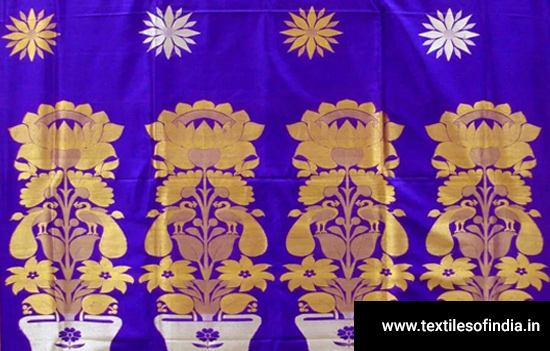
Reference and Credits
Reference
and Credits
4. Madhavaram
Madhavaram
is a small village, situated on the banks of river Penna, in the Kadapa district.
Madhavaram
sarees have petu border with jacquard or zari pallus. Most of these sarees are
brightly coloured and can be used for daily and occasional wear. The weavers of
Madhavaram produce 6 yards sarees specially meant for brides.
Moduga
Puvvu from the nearby forests
are used for the reddish border of bridal sarees. Weavers mostly use vegetable colours
for dyeing. Even Madhavaram Madhuparkams (the
single wrap of dhoti and saree for the bride and bridegroom) are famous. The
use of natural colours like green, yellow, red, orange, maroon, etc. is common
in these sarees.
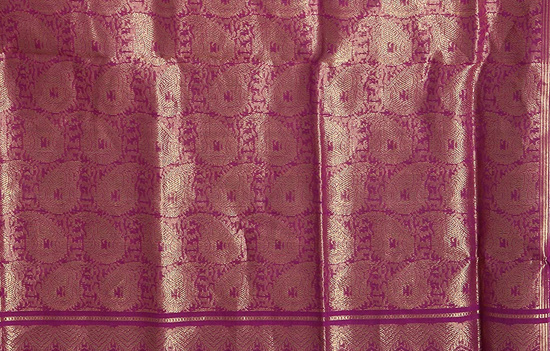
Reference
and Credits
Reference
and Credits
– good read.
5. Dharamavaran
Origin and history
Dharmavaram
sarees are the exclusive patronage of the town of Dharmavaram, in the
Anantapura district of Andhra Pradesh. This ancient town gets its name from
Dharmamba, who was the mother of Kriya Shakthi Vodavaru Swamy, the founder of
the town.
The
town took to silk weaving due to the abundance
of mulberry trees around the area, which makes for a natural breeding
ground for wild silk worms. By the 19th century,
the mulberry silk Dharmavaram sarees found nationwide
recognition for the sheer brilliance and beauty of the weave.
Making of Dharmavaram Sarees
It
requires two artisans to weave continuously for 6 to 7 days with mulberry silk
and zari to complete a Dharmavaram saree. Dharmavaram can be used to make
skirts as well. The popularity of art has increased its demand among all women.
To
meet the market demand sarees are now being produced using machines. Machines
do not have the same look and feel of handmade products but are still
considered as good as handmade ones.
According
to their design and style, Dharmavaram sarees have different name for example
Dharmavaram temple pallu saree, Kala Anjali Dharmavaram sarees, etc.
Dharmavaram
saree has motifs of flora and fauna woven into its fabric. Dharmavaram’s zari
work makes it stand out in the crowd of other sarees. Other designs are
inspired by temples and old paintings. Commonly used zari threads are red,
green, silver, and golden.
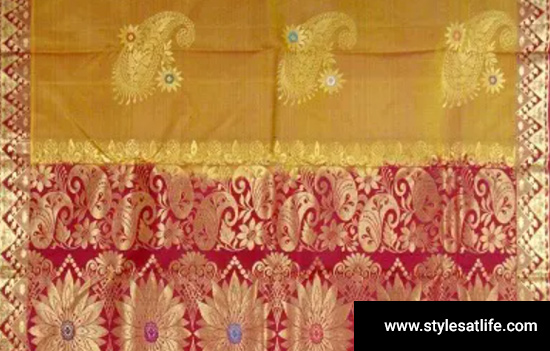
Reference and
Credits
6. Gadwal, Telangana
Background
Gadwal
sarees are produced in Godwal and surrounding areas, in the district of
Mehabubnagar. It is about 200 kms from Hyderabad and near the banks of river Krishna.
The
origin of Gadwal Sarees can be traced back to about 200 years. Then Gadwal was
the capital of a small kingdom, locally called as “Samasthanam.” The Maharani of the kingdom ‘Adhi Lakshmi Devamma’ promoted the craft with the help of a few
weavers who had come to Gadwal from various coastal areas. Initially Gadwal
Sarees were called as ‘Mathiampeta’.
The Beauty of a Gadwal Saree
Gadwal
sarees are a beautiful and ornate part of the rich Indian textile heritage. A
Gadwal sari is known for its rich look, brilliants colours and simple yet
ornate zari work.
The
specialty of a traditional Gadwal sari is that the body is woven in cotton
threads while the border and pallu are made of silk. This aspect of textile
diversity attracts many women as it is unconventional and uncommon, even in
India. This is done using a special weaving technique that manoeuvre’s the weft
thread.
There are a number of different elements that work together to
make the Gadwal sari such a desirable sari. It is known for featuring one colour on
the body of the saree and another on the border and the pallu. One of the main
reasons why women prefer buying a Gadwal sari is that the Gadwal shows some
really brilliant contrasts as well as subtle and elegant distinctions with the
option of subtle, well-spaced embellishments. The range of colours to choose
from is very vast and tends to suit different style sensibilities.
The
other attractive feature is that Gadwal sarees showcase luxurious and elaborate
zari work on the border and the pallu, making them simply beautiful to behold
and ideal for formal events. The zari embroidery on the pallu of a traditional
Gadwal sari fills the width and breadth of the available area and is extremely
intricate. It is not necessary that this work be done in strips or simple
weaves; traditional patterns such as the nature inspired paisley and peacock
motifs as well as others that are inspired by religious architecture are also
used to embellish this classic saree.
The
border may be thick or thin and can usually be classified as traditional and
modern. As embellishments in the saree go, most Gadwal sarees have tassels made
from the warp filaments of the fabric itself. This gives the saree a beautiful
look and also adds to the beauty of the wearer.
It
is interesting to note that since the Gadwal sari is a handloom textile it is
considered as an important part of a bride’s trousseau and gifting the bride
silk Gadwal sarees is a matter of pride in south India.
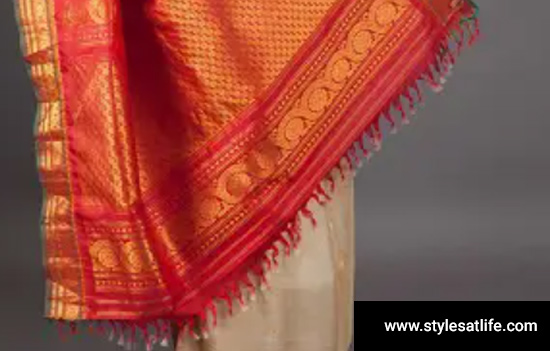
Reference and Credits
Reference
and Credits
7. Uppada Pattu Sarees
Uppada
Pattu sarees are made from the age old Jamdani method. These sarees are famous
for the unique designs. Weavers use non-mechanical techniques in weaving these
sarees. Uppada Silk sarees are described by the length and breadth count of
threads. Light weight is the speciality of these sarees. The colours used in
these sarees are very attractive. These are worn on special occasions.
History of Uppada pattu sarees
Before
knowing the story of Uppada Silk, one has to know the course of the Jamdani
weaving method. After a lag in the 19th century due to the manufacturing
failure in England, Jamdani witnessed a moderate improvement in the 20th
century. As a result, the method of Jamdani was introduced in Uppada where it
included designs which became popular in Andhra Pradesh. Thus started a new variety
of silk sarees named Uppada Silk Sarees.
Moreover,
it took about ten years for Uppada Sarees to get appreciation. The name Jamdani
in Uppada Jamdani Sari is part of Persian vocabulary, in which Jam is flower
and Dani is Vase. Jamdani style of weaving was started in Bangladesh. In the
18th Century, it was taken to the south and in Uppada village of East Godavari
region, Andhra Pradesh.
Measurements and weight of Uppada pattu saree
For
weaving Uppada silk sarees, the length of strings is 100 and the width is also
100. For Jamdani style of weaving two weavers will work on a single loom to
produce delicate and wonderful patterns on the saree.
The
count which is used in weaving of these sarees gives softness to the fabric. In
hand loom weaving, fabric count means the number of threads woven length and
breadth wise. This type of weaving is also known as warp and wept respectively
in a square inch.
Why Uppada pattu sarees are lightweight
Uppada
pattu sarees are very light compared to other sarees. The weaving pattern is
jamdani class. Because of using pure zari these sarees are said to be light
weight. The patterns and themes of Upppada silk are very unique and the bright colours
make the saree appear even lighter.
These
beautiful Uppada pattu sarees were weaved with silk, gold and silver zari
threads. Women prefer to wear these Uppada silk sarees on their wedding and
other special occasions.
Being
light in weight, the floral designs, peacock or curved motifs in the Jamdani
pattern, perfectly aligned in margins and a beautiful matching pallu, make the
saree look extremely attractive.
Types of Uppada sarees
Weavers
of uppada sarees have developed many patterns and varieties. Here is the list
of different types of uppada sarees.
•
Plain uppada pattu sarees
• Multi colour uppada sarees
• Half and half uppada sarees
• Checks uppada sarees
• Big border uppada sarees
• Uppada pattu saree with big pallus
• Uppada Cotton sarees
• Uppada pattu saree with pocahampally border.
How to identify Uppada Jamdani Sari
In
Uppada weaving style, the designs are two-sided i.e., when we touch the cloth,
we can identify that the design is not separate from the cloth. There will be
no loose threads on either side of the saree.
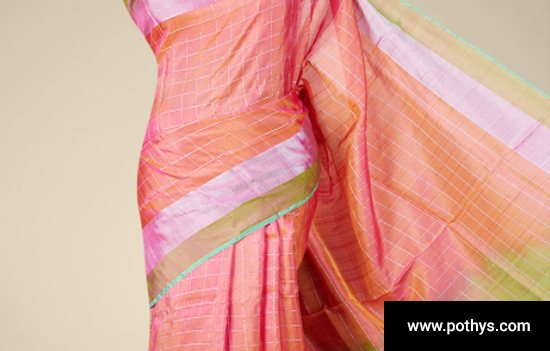
Reference and
Credits
Reference and Credits
8. Ponduru Sarees
Ponduru
is a town in the Srikakulam district of north Andhra Pradesh.
Ponduru
khadi is one of the finest khadis produced in the country. It is said that when
Acharya Vinoba Bhave visited Ponduru he was gifted a khadi dhoti which was
three metres long. It was so fine that it could be packed into a matchbox!
What
makes Ponduru khadi so interesting is the painstaking procedure of weaving it.
It is produced from indigenous organic cotton of a very short staple length.
Two types of cotton are used to make Ponduru khadi: the red or Punasa cotton,
and the white or hill cotton. While the red cotton gives a metric count of 44-65,
the white count gives finer khadi with a metric count of 71-100.
There are eight steps which go into preparing this fabric. First, the
cotton is cleaned in a unique manner. The serrated jawbone of the Valuga fish
which is found in the fresh waters of the Godavari River is used to remove
impurities from the cotton. Step two is where the seeds are removed from the
cotton by rolling a thin wooden stick over it. The third step is called
paralleling. It involves removal of more impurities from the cotton using a
thin broomstick.
The
fourth step called slivering, involves further deep cleaning of the cotton
using a nylon thread and bow. This cotton is then spun in the next step and
placed in dried banana stems. This process of fine spinning is different for
the red cotton and white cotton, and yields different metric counts. The next
step involves making this thread into sutgundis. These threads are then
coloured and painstakingly woven into khadi fabric using the single wheel
charkha.
Ponduru
sarees are single colour sarees woven in cotton. Temple border is finely
patterned on these sarees, making them exclusive and exceptional. Made popular
during the Swadeshi movement by Gandhiji, these sarees are an excellent
combination of strength and finesse.
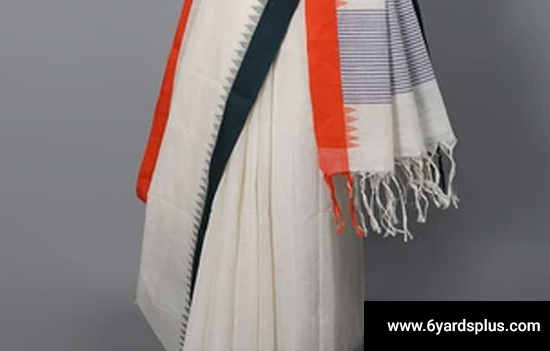
Reference and Credits
Reference and Credits – good blog
The
purpose of this compilation is to document and promote. We have given credits
and reference links in this compilation along with third party links (to
promote). In case some are missed, it is not with malafide intent. Please
email full details to esamskriti108@gmail.com
and we shall effect the change.
To read all
articles by author
To
read about Handloom Sarees of Odisha
To
read all articles on Traditional Textiles of India
Author Trishna
Patnaik
is a self-taught
artist based in Mumbai, Trishna has been practising art for over 14 years. She
is now a full-time professional painter pursuing her passion to create and
explore to the fullest. She conducts painting workshops across India. She is
also an art therapist and healer who works with clients on a one to one basis.
Not to forget her quality writings on Indian Art and now Textiles for
esamskriti. She fancies the art of creative writing.